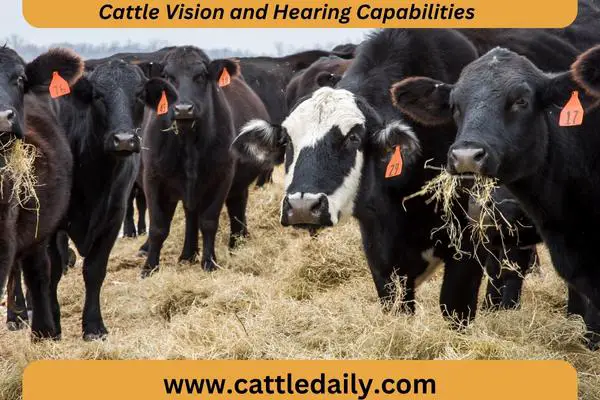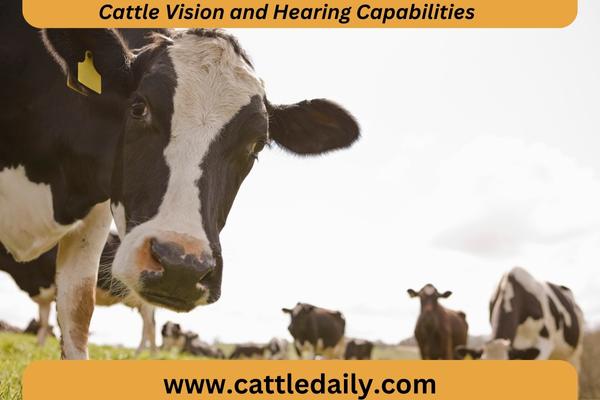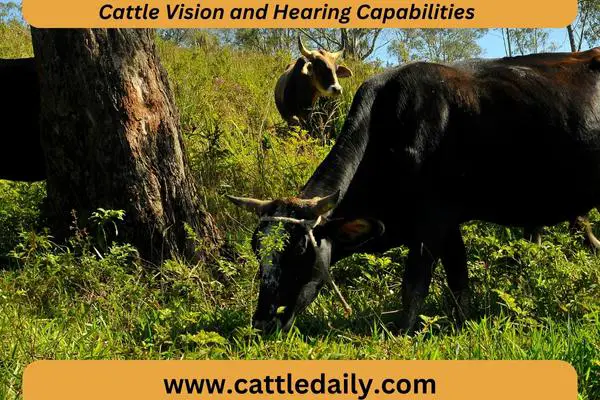Cattle Vision and Hearing Capabilities
Cattle have unique vision and hearing capabilities that allow them to perceive the world around them. Understanding cattle senses can help farmers and ranchers provide better care.
In this blog post, we will explore cattle vision, including field of view, color detection, depth perception and more. It also covers cattle hearing ranges, directional hearing, and how vision and hearing influence behavior.
Cattle Field of Vision
Cattle have an almost panoramic field of vision, allowing them to see nearly 360 degrees around their body. Their eyes are positioned on the sides of their head rather than the front.
As a result, cattle have better peripheral vision but reduced depth perception compared to predators like wolves or humans whose eyes face forward.
The wide field of vision gives cattle early warning signals about approaching predators or perceived threats. For example, if something moves into their line of sight from the side or behind, cattle will immediately notice.
This gives them time to react defensively if needed. Their natural vigilance helps them stay attuned to any danger.
At the same time, having eyes on the sides of their heads leaves cattle with blind spots directly in front and behind their bodies. Cattle compensate by swinging their head from side to side to scan more effectively. But the blind spots do make it possible for predators to sneak up very close before being detected.
Cattle Color Vision Capabilities
In addition to a panoramic field of view, cattle also have color vision. They see shades of blues, greens, and yellows quite well. Scientists have studied and documented cattle interacting differently with red items compared to blue, green, or yellow items of the same shape and size.
However, unlike humans who have trichromatic vision with receptors for red, blue, and green light, cattle are dichromats. They have two types of color receptors, most sensitive to yellowish-green light around 555 nm and blue-purple light around 445 nm wavelength.
As a result, cattle have trouble distinguishing red from green or orange from grey colors. So, while cattle can detect some color variation, their color perception is limited compared to humans.

Depth Perception and Judgement in Cattle
Because a cow’s eyes are placed on opposite sides of their skull, they lack the overlapping fields of vision humans have. This greatly reduces their depth perception and ability to judge distances accurately.
As prey animals, correctly perceiving depth and distance is not as critical for survival as having an extensive panoramic view to watch for threats.
Cattle may swing their heads from side to side to gain more perspective and depth information. But even so, their depth judgment remains inferior compared to predators.
As a result, cattle sometimes refuse to cross small ditches, streams, shadows or other hazards a human would easily traverse. Understanding their visual limitations can prevent frustration when working with cattle.
Cattle Hearing Range and Capabilities
In addition to vision adapted for vigilance, cattle also have excellent hearing capabilities. Their sense of hearing helps compensate for visual limitations in front and behind.
Cattle have a wider hearing range than humans, able to detect sounds pitched below and above what the human ear can perceive.
For example, cattle can hear infrasonic sounds ranging from 23 Hz to 35,000 Hz. The typical human hearing range is around 64 Hz to 23,000 Hz. So cattle hear both higher and lower-pitched sounds. Their ears can also rotate to channel sounds from their full 360-degree surroundings.
Interestingly, cattle hear equally well with either ear and lack the ability to detect which direction a sound originates from.
But by moving their head and ears, cattle are very good at localizing sounds to detect potential threats. Cattle hearing is also more sensitive than human hearing at comparable noise exposure levels.

How Vision and Hearing Influence Cattle Behavior
Both vision and hearing work together to help cattle maintain vigilance against danger. As prey animals, cattle have evolved sensory adaptations to best avoid predation in open country. Their eyes are positioned to scan an extensive visual field for trouble. Their ears rotate to catch a wide range of audible cues.
The placement of cattle eyes and directional hearing allows them to monitor for threats in almost all directions continuously.
Having limited depth perception is less critical than maximizing visible area. As a result, cattle rarely relax their guard and remain ready to take flight if needed.
Understanding limitations in vision and hearing capabilities also explains some cattle behaviors. For example, balking at shadows, ditches or puddles results more from poor depth perception than stubbornness.
Loud noises can panic cattle because their sensitive hearing picks up intense sounds humans barely notice.
Knowing how cattle see and hear the world can help farmers move livestock more effectively. Slow movements in full view are less likely to trigger escape instincts keyed high by their sensory adaptations as prey animals. Having realistic expectations based on biological factors will lower cattle handling stress.
Importance of Vision and Hearing for Grazing Cattle
Cattle are grazing livestock, meaning the majority of their diet consists of eating grass and other growing forage.
As a result, their vision and hearing adaptations play an integral role in finding food and detecting threats while grazing. Understanding how cattle use their senses can lead to better pasture management.
1. Vision for Identifying Edible Forage
A cow’s eyes are perfectly adapted to scan wide stretches of pasture for their next tasty bite of grass. Their panoramic field of view allows a cow to scan up to 300 degrees while walking with their head down grazing.
The sideways placement of their eyes lets cattle spot lush green pastures within their peripheral vision.
At the same time, cattle’s dichromatic color vision helps them differentiate between healthy growing forage and dried-out or dead grass. Pinpointing the most nutritious available feed makes cattle grazers more efficient.

2. Hearing to Detect Predators While Grazing
Cattle also rely heavily on their sensitive hearing while grazing with their head down. In natural settings, predators like wolves or cougars often use terrain like hills or brush to stalk close before attacking.
Since cattle have a blind spot directly in front while grazing, hearing alerts them to threats approaching from that direction, their ears also swivel to catch sounds in a 360-degree radius. Any unusual noises will instantly capture a grazing cow’s attention.
Quick detection from hearing cues gives cattle time to lift their head to confirm danger visually. Early warning then allows cattle to flee to safety from approaching predators. Sudden disruptive noises, while cattle are grazing, can trigger the same survival instinct to take flight.
3. Maximizing Pasture Usage
Because cattle depend so heavily on vision and hearing while grazing, setting up pastures with these senses in mind can improve productivity. Rotating livestock through multiple pastures provides fresh forage that is easiest for cattle to identify from a distance visually.
Separating adjacent pasture usage also minimizes disruptive noises that might startle grazing cattle. Staying quiet when checking or moving grazing livestock prevents triggering unnecessary flight reactions.
Making an effort to move carefully and quietly around grazing cattle allows them to maximize their prime focus – identifying and harvesting the most nutritious forage. Leveraging natural cattle vision and hearing adaptations can lead to higher carry capacities on well-managed pastures.
In summary, cattle have specialized vision optimized for detecting peripheral movement and color rather than visual acuity and depth perception.
Their hearing outpaces human capacities in both upper and lower sound ranges. Combined, bovine vision and hearing help cattle remain vigilant for potential threats approaching from any direction. Taking cattle sensory capabilities into account when moving livestock will facilitate lower-stress cattle handling.


